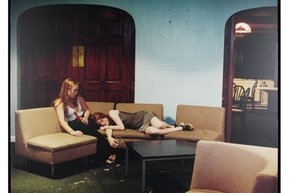Today we had an ex Plymouth College of Art student now professional commercial photographer Tony Cobley come in and talk about his background and current practice and the process/progress that took place to get him to where he is. Cobley graduated back in 2008, he now mainly operates in the South West, living just outside Plymouth city.
Cobley has been interested in photography from a young age, describing his interest as ‘happy hobby photography’, he enjoyed the idea of capturing different scenes. But for a large part of his early career, Cobley didn’t practice photography. It was due to a back problems which led Cobley to making a huge change in his career, this is where he decided to go back to college and study for a full honors degree as a mature student. In the same month that Cobley started his degree he also started his business; it was at this time in 2005 where he vowed that photography would be his only form of income, he was fully commited.
During the talk today Cobley highlighted on many occasions the importance of formal training, and that many people pick up a camera and automatically promote themselves as a photographer. But Cobley, made apparent the significance of study, and the understanding of how a camera and industry works.
While studying at Plymouth College of Art, Cobley underwent many projects, continually experimenting and exploring various avenues in which he could create work and work within. Initially Cobley found himself drawn to landscape photography, enjoying the natural shapes and forms of the English scenery, working on medium format, which created elegant transparency in his imagery which Cobley enjoyed producing. Cobley relished this technique of working, so decided to apply the same technique but changed subject matter. Being fascinated by the seaside and coastal areas, this is where he found himself primarily working. At the time Cobley was highly influenced by Martin Parr, Cobley explains, that this influence is visually reflected in his work.
Cobley found himself working quite comfortably on the coastline, he experimented with various methods of working, taking on a very documentary approach, producing beautiful black and white images, which depicted very picturesque street scenes. This allowed him to establish a very traditional, modernist stylistic, resulting in very elegantly timeless seaside front images. Once Cobley had pursued this path, he found himself wanting to create more post-modernist images, using colour, depicting imagery of decay, ‘punchy’, ‘tacky’ seaside fronts. Cobley ironically found out, that once you go looking for a shot, is that, that shot never appears. He found patience was a much needed attribute while shooting, as most of the time he found himself waiting around for sparks to happen to create that all important shot.
Throughout his talk Cobley emphasized the importance of experimentation, while at college, due to the facilities and equipment available. During his final year at the college, Cobley worked primarily on large format, using 5×4 inch film. Strongly recommending that we as students try as much as possible and seize all opportunities and then gravitate what works for you. Work based learning is a concept Cobley promotes; work experiences, assissiting already established photographers. While studying Cobley both worked for a and volunteered for numerous companies and photographers. Working commercially for Trevor Burrows, portraiture assisting Venture and location photography for SW Screen. As well as starting his personal business promoting himself as a freelance photographer.
These are a few of the areas in which Cobley works within:
- Food and Drink
- Corporate Portraits/Lawyers/Boardrooms
- Medical/Scientific
- Industrial/Technical
- Lesiure and Tourism
- Education
- National Trust
- Environmental Product
- Architecture/Interiors/Exteriors
- Health and Well being
- Events/PR
- Stock/Landscape
Examples of Commercial Clients:
-Occasionally via agencies
- National Trust
- Toshiba
- Lexus
- Royal Marines
- Devon Air Ambulance
- Asda
Working as a commercial photographer, has many restrictions and you are constantly working to a client brief, so vary rarely is there ever any artist licence to contribute. Cobley made apparent the importance of keeping your passion alive by having personal projects which are entirely your own, it allows you to still keep a sense of enjoyment and pleasure. Cobley’s has an array of on going personal projects which he is ever expanding, these range from ‘Structures in the Landscape’; concentrating on shapes and forms, the idea of man-made in wild places. ‘The Pony Project’, Cobley lives just on the outskirts of Dartmoor, thus frequently photographing and documenting the landscape, and its contents; describing these images as ‘not typically equine’. Cobley also is undergoing a project of photographing Union Street in Plymouth city center; interested in textures, colours, alluring archaic aspects. Depicting gritty back street views of decay and deterioration. And finally due to Cobleys health issues with his back, having an operation which put him out of practice for a short while, but in that short while he found himself drawn to the sky and the idea of looking up at the clouds capturing the strange shapes and obscure forms which consumed the world above.
I thoroughly enjoyed today’s talk, it was refreshing to hear from a photography, who supports himself entirely from his photographic career, and the idea of it is possible, is a reassuring one. I think a positive from today is that you shouldn’t ever give up, and that working hard is just the start of it. You have to put yourself out there in order for opportunities to arise and be created.
………………………………………………………….
A few of my favourite images of his:
Black and White Documentary.





……………………………………
A few of Tony Cobleys sites:
Home
https://www.facebook.com/pages/Tony-Cobley-Photography/318793731621
http://uk.linkedin.com/pub/tony-cobley/13/b32/751
…………………………………………………………………………






























